Art & Exhibitions
Glasgow International Kicks Off 7th Edition With Extravagant Performance
The 2016 edition of the festival cements Glasgow's arts hub reputation.
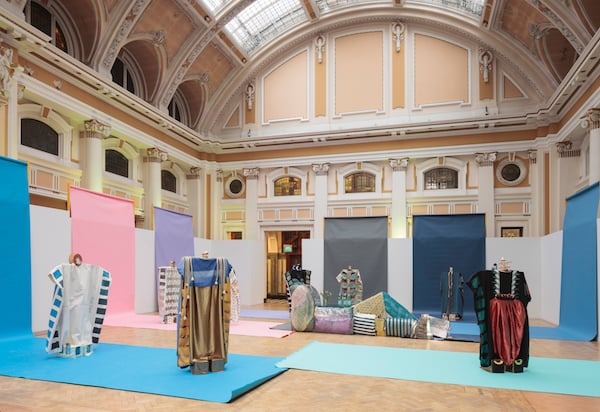
Photo: Ruth Clark.
The 2016 edition of the festival cements Glasgow's arts hub reputation.

Hettie Judah

The 7th edition of the Glasgow International (GI) festival opened with a gaudy, often quite naked, happening orchestrated by Marvin Gaye Chetwynd and Jedrzej Cichosz that involved sweet potatoes, spoken word, and a tiny motorbike. Such party pieces are only one aspect of a wide spectrum of programming that also took in a performance at a roller disco, enforced collaborations shown in a former glue factory and a guided audio tour to a municipal library.
Glasgow International is a festival of unusual scope, spanning art projects from the most local, to glossy productions such as Amy Siegel’s globe-trotting design-fetish film Provenance (2013), here handsomely screened in a cavernous space at Tramway. While the neighborhood-based multimedia project Workings, lodged among the housing estates in Firhill, may not share anything close to Siegel’s budget or ambition, Siegel doesn’t offer you a cup of tea and chocolate biscuit for visiting her space, so, y’know… swings and roundabouts.
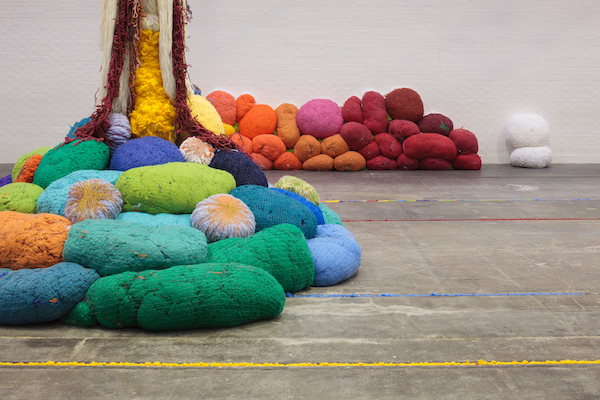
Installation view of Sheila Hicks’s work at Glasgow International.
Photo: Ruth Clark.
Provenance forms part of GI director Sarah McCrory’s curated program, nominally themed around Glasgow’s industrial heritage and the return of craft skills and handmaking. At Tramway, we find Mika Rottenberg’s artfully staged, fleshy film works shown alongside Sheila Hicks’s swoops and tussocks of colored fiber. Alexandra Bircken’s Trolley I & II (both 2016) are nomadic objects fitted to the defunct tracks still gouged into the floor of Tramway—they’re dressed with panels of delicate, weblike weaving, the grids of which draw in hanks of hair and yarns of hi-viz orange and gauzy gold; tones of the body, industry, and wealth.
The weak point comes when the program’s themes are addressed over-literally, specifically in Lawrence Lek’s computer graphic video QE3, which imagines the luxury liner QE2, constructed in Glasgow’s dry docks in the 1960s, towed back to the city to house its School of Art a century later.
Elsewhere at Tramway, a more substantial theme emerges around the generation of value. Rottenberg’s depictions of female labor are choreographed around sculptural structures and surreal scenarios: plastic models of food are sneezed out as the side effect of a pollen allergy (Nonoseknows, 2015), and tubs of sparkly blusher pop from rosy squashed cheeks (Squeeze, 2010).

Installation view of Amie Siegel’s work at Glasgow International.
Photo: Ruth Clark.
Siegel’s Provenance tracks Le Corbusier and Pierre Jenneret’s furniture designs back from superyachts and the lofts of wealthy hipsters, through auction houses, upholstery workshops, and shipping warehouses to the offices and rooftops of Chandigarh, before eating its own tail as the film itself is auctioned at Christie’s London. In both, value is shown as at once mysteriously disconnected from labor, and by extension, as the product of a certain amount of sales voodoo—in the art world perhaps more so than anywhere else.
The director’s program spreads across sites both formal and informal around the city. The dilapidated Kelvinhall hosts captivating double-sided canvasses by Helen Johnson that explore aspects of Australian history and social mythology, looping in classical sources that underpin European cultural identity. Recto of The Rape of Europa (Australian Version) (2016), we see the titular Phoenician born away by the familiar white bull. On verso, Johnson offers the account of an early settler in Australia observing with shame the irreparable damage done by the European livestock driven across the territory, their ravaging of the virgin landscape marked with a cloven hoof.
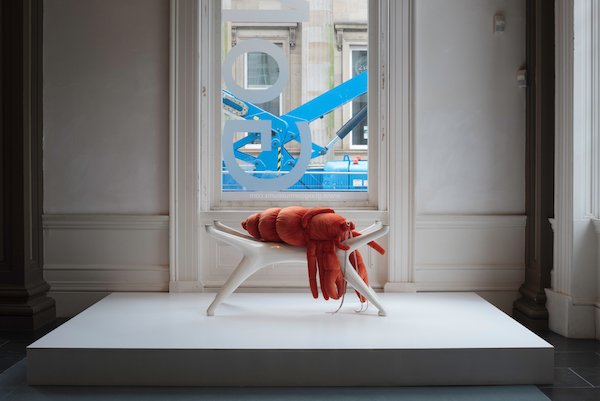
Installation view of Cosima von Bonin’s work at Glasgow International.
Photo: Ruth Clark.
At the city’s Gallery of Modern Art, in a crowd-pleasing and deliciously eccentric display centering on plush undersea creatures created by Cosima Von Bonin, a hermit crab lounges on a vintage sunchair and a great white shark lolls despondently at a Modernist office desk. Footage of a drag dance-off, shown in a stage-like central section, throws out complicating ideas connecting to costume, display, performance and the ease with which appealing cartoonish animal forms elicit anthropomorphic self-identification.
In a hothouse at the Botanic Gardens, Aaron Angell’s ceramic sculptures nestle amongst the begonias. Architectural structures built from tiny clay bricks, with a nod to the wobbly historical dioramas shown in local museums, here the play with scale is given pleasing extra dimension as tiny ants scuttle about in front of the siege equipment and sapid flowers fall and desiccate alongside their ceramic brethren.
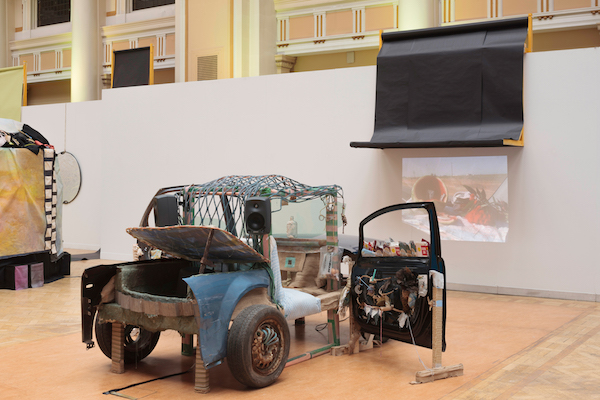
Installation view of Tamara Henderson’s work at Glasgow International.
Photo: Ruth Clark.
Shamanism and altered states inform works by Tamara Henderson and Serena Korda. Henderson’s Seasons End, showing in the Mitchell Library as part of the director’s program, offers an oneiric pantheon of costumed figures evocative of lunar rites. Set against the rolled color backdrops used in photography studios, the ambitious work draws parallels between the ephemera and rituals of cinematography and the visions evoked by herbal magic.
At the Glasgow School of Art’s Reid Gallery, Korda’s Hold Fast, Stand Sure, I Scream a Revolution (a festival highlight) is inspired by ‘thin places’: mythological touching points between one world and another. The work centers physically on a suspended circle of porcelain bells delicately sculpted in the form of Psilocybin mushrooms, but gathers its power in a binaural sound work developed with composer Martin Low.
The expanded nature of Korda’s work—taking in not only sculpture and technically experimental sound, but an archival display looking at both the island of Mull and cultural radicalism of Glasgow’s Garnethill neighborhood, and a community project in which local teens are trained as “agitators” able to animate the bell orchestra—is emblematic of GI as a whole.
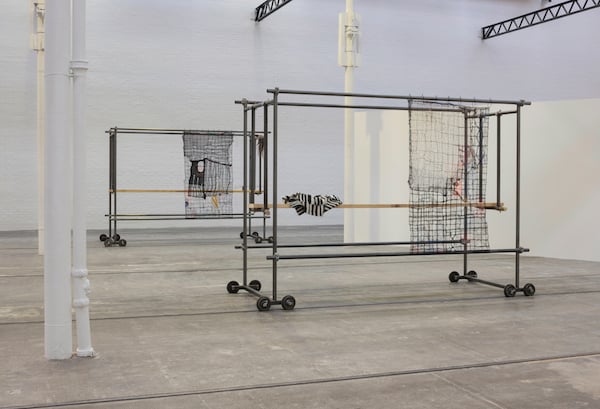
Installation view of Alexandra Bircken’s work at Glasgow International.
Photo: Ruth Clark.
That background research is so often foregrounded in the presentation of projects—often to the detriment of artworks to which it eventually bears little relation—is perhaps one side effect of an arts culture strongly dependent on funding applications.
But here, too, is an unusually strong determination to engage with the wider city, both actual and historical. Projects from well-established cultural organizations working in prisons or with artists with learning disabilities are presented alongside the slick output of internationally-regarded commercial galleries with no distinction of status in the festival program.
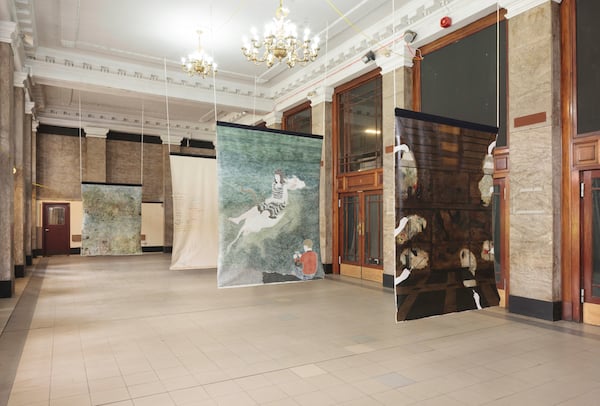
Installation view of Helen Johnson’s work at Glasgow International.
Photo: Ruth Clark.
Eighteen hours after the opening performance by Chetwynd and Cichosz, Ghanaian musician and storyteller Gameli Tordzro performed works inspired by themes of migration and refuge to a small audience in a vegetarian café just metres down the road. It speaks much to the richness of this festival—and its multifaceted interpretation of the term “international”—that it can so comfortably make space for both.
The 2016 edition of Glasgow International is on view from April 8-25 across several venues in Glasgow, Scotland.